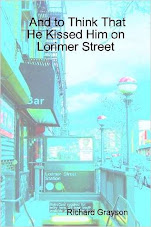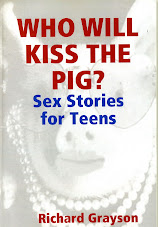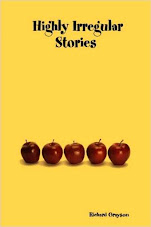
This evening we heard a fascinating talk on the ecological restoration of the Pennsylvania and Fountain Avenue landfills by the Belt Parkway that we used to ride or drive by practically every week on our way to and from the exit near our house (Flatbush Avenue) and anyplace east, as close as the Cross Bay Boulevard exit or as far as far as we'd go on Long Island.

We learned to try not to breathe deeply so we could avoid the putrid stench, which we can still smell in our sense memory decades later.

But now these hilly dumps have been transformed into 400 acres of nature preserve, restoring native habitats that disappeared from New York City long ago, and tonight John McLaughlin, who directed the ecological rehabiliation there, discussed how it was done. He spoke at the Metropolitan Exchange (MEx),

a wonderful architecture, urban planning, and research cooperative whose design professionals, developers, and scholars who come together to collaborate on architecture and planning projects, pursue development opportunities, and sponsor lectures, film screenings and exhibitions.

They've got a great space on the sixth floor of 33 Flatbush Avenue, a building we've passed all our lives but never had gone into before.

It was an easy walk from the Fulton Street G train stop, but a less easy walk up the six floors (the elevator was broken) but certainly doable and probably good exercise. In any case, the presentation was well worth it. There was cheese and crackers and wine for members and others attending the talk, and we signed in and checked out the space a little.

This interesting lecture and PowerPoint presentation is part of the Freshkills Park Talks series. Today's New York Times featured an article, "Turning Trash Piles into a Bird-Watcher's Paradise,"

about the gradual transformation of Staten Island's famous (and very large) Fresh Kills landfill into Freshkills Park.

The New York Times gave the basics in an article last September on the Pennsylvania and Fountain landfills' ecological restoration:
In a $200 million project, the city’s Department of Environmental Protection covered the Fountain Avenue Landfill and the neighboring Pennsylvania Avenue Landfill with a layer of plastic, then put down clean soil and planted 33,000 trees and shrubs at the two sites. The result is 400 acres of nature preserve, restoring native habitats that disappeared from New York City long ago… Once the plants take hold, nature will be allowed to take its course, evolving the land into microclimates. In some areas that turned out to be damper than had been foreseen, sassafras and black oak, which prefer dry soil, are not doing as well as expected, but other plants should prosper, Mr. McLaughlin said… Birds including ospreys, egrets and snowy owls are spotted and counted at the former landfills.

Eloise Hirsh, the Freshkills Park administrator, talked about this series of talks, which wil continue throughout the winter,

and introduced John McLaughlin, who has been involved with ecological restoration for 23 years, the last 17 at the Department of Environmental Protection, and before that, with the Sanitation Department.

John McLaughlin used a PowerPoint presentation with lots of charts and photos, to discuss his work on the Brooklyn landfills.

Their combined size, of course, is much smaller than the Staten Island landfill, and the Brooklyn landfills are also, unlike Fresh Kills, class 2 inactive hazardous waste sites.

John gave some of the history of the Brooklyn landfills, which began in 1956, when we were in kindergarten at P.S. 244, with a brief hiatus starting in 1962, when we started J.H.S. 285, and resumed taking on the city's trash in 1968, the year we graduated Midwood H.S. In 1974, the landfills were included in the deal for the Gateway National Recreation Area, so they're unders the jurisidiction not of the city or state but the federal government.
Pennsylvania and Fountain Avenues stopped taking on garbage in the early 1980s, after we left the city. The restoration projected began in 2002, with the landfills being capped in 2005-06 and then seeding and finallly planting began.

You can get a sense of the project from this interview John McLaughlin did with WNYC in February 2007:
Planting a tree requires an act of faith. They take years, sometimes decades to reach their prime. So, John McLaughlin’s faith in the future is something to admire. Because tree by tree, he’s planting a forest.
MCLAUGHLIN: Those are Virginia pine….there are three types of pine in here. Virginia pine, short leaf pine and pitch pine….
REPORTER: And not just any forest. This is going to be a Northeastern coastal woodland, using plants native to our area and selected specifically for this site. McLaughlin’s also planting native drought-resistant grasses...wildflowers.…holly, swamp azalea…even prickly pear cactus.
McLAUGHLIN: Here’s the cactus. When you look at it this time of year, it’s like, eek, It looks all shriveled up…that’s its normal characteristic this time of year.
REPORTER: McLaughlin’s forest will someday cover two Brooklyn landfills, the Pennsylvania Avenue and Fountain Avenue landfills. You can see their big, grassy mounds along the Belt Parkway, near exit 14. Usually, the Department of Sanitation handles landfills. But the Department of Environmental Protection got involved in the early 90s. It took control of Penn, Fountain, and two other landfills, after the feds banned ocean dumping. Ultimately, the DEP found other ways to get rid of its sludge, but it still has these old landfills to deal with. And that’s where John McLaughlin comes in. He’s DEP’s Director of Ecological Services.
McLAUGHLIN: The Department saw this as a great opportunity to take nearly 400 acres of open land near a very sensitive area such as Jamaica Bay and convert it to ecologically valuable habitat.
REPORTER: Once a landfill is capped, and covered with soil…once its dangerous methane gas and toxic ooze are dealt with….it seems logical to try to restore its ecology. But the DEP is not required to do this. And it's relatively new idea.
SAUER: The regulations required that you grow turf, lawn, basically, and mow it for 30 years. The problem is, it certainly has nothing to do with a very useful end use in the area.
REPORTER: That’s Leslie Jones Sauer, the founder of Andropogen Associates, which pioneered the concept of environmentally-sustainable landscape design. In the late 80s, John McLaughlin was part of a team charged with the future of the Fresh Kills landfill on Staten Island. At two thousand, two hundred acres, Fresh Kills would make a mighty big lawn…so the team asked Sauer’s firm to come up with something else. First things first, Sauer told them: you’ll need more dirt.
SAUER: the problem we encountered in looking at the regulatory requirements is that they required very little soil on top of that impermeable cap. And the idea of supporting any vegetation for a long haul was really kind of bogus.
REPORTER: If you put at least three feet of soil over a landfill’s plastic or clay cap, she told McLaughlin, you can avoid decades of lawn care. You can restore a native landscape that will take care of itself. And you can even start planting…..trees! The idea was heretical to landfill engineers...

A lot of John's talk was technical, and we suspect urban planners, environmental specialists, landscape developers and horticulturists made up a lot of the sixty or so people in the audience.

We learned a great deal, however, about the problems they encountered, like tree roots (actually, less of a problem than laypeople might think, since with the slightest pressure they grow laterally and shallowly way, way past the tree crown) and voles, which like to chew branches.

Another concern was the proximity of Kennedy Airport, whose administration, for example, didn't want flight interference from avian species like geese who might like hanging out in the new habitat. (As John said, never mind that the airport was thoughtlessly built in the middle of sensitive wetlands.)

They used indigenous plant communities, and John spoke about the care needed in selecting contractors who understood that, environmental rather than engineering laboratories to do testing, and the myriad other choices necessary in doing the job effectively.

We were a little surprised that aesthetic values play very little role in the planning. It's a big plus that things look pretty, but the foremost concern is restoring the natural ecology, and that means considering factors like genetic diversity rather than providing park use for surrounding neighborhoods. (As John pointed out, nearby East New York is historically underserved by parks, and community activists did play a role in the planning, but the main concern is environmental.) Obviously they can't return to the pristine Jamaica Bay wetlands they were centuries ago, but then neither can most of the southern neighborhoods of Queens and Brooklyn, like our own Mill Basin.)

Anyway, there's a lot more that we learned about the Pennsylvania and Fountain projects, and we're looking forward to seeing it close up in the future. Back in the day, we sort of were fond of the landfills despite their stink as we passed, but then we just adored the majestic, if smelly, Mount Trashmores

across the country, especially in South Florida, where we mostly lived from 1980 to 2005, and the landfills were often the highest peaks around. In our town, Davie (and where we ran for the town council in 1982), the landfill - though without the environmentally sensitive and innovative restoration John McLaughlin described tonight in the Brooklyn sites - became a place we liked even more, Vista View Park.

We're grateful for the fine work the DEP did on the landfills of our younger years in southeastern Brooklyn and can't wait to see Freshkills Park, which will be three times the size of Central Park.

In our time in Staten Island - we got our M.A. at Richmond College (now part of the College of Staten Island) 35 years ago and spent a lot of time there once we were old enough and nonphobic enough to drive over the Verrazano Bridge - we used to hang out at Clove Lake Park and Silver Lake Park, but Freshkills Park should be even more beautiful. As Bette Davis said in Beyond the Forest, "What a dump!"

































































































